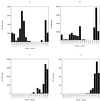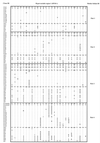Dominant role of host selective pressure in driving hepatitis C virus evolution in perinatal infection
- PMID: 10756048
- PMCID: PMC111950
- DOI: 10.1128/jvi.74.9.4327-4334.2000
Dominant role of host selective pressure in driving hepatitis C virus evolution in perinatal infection
Abstract
The dynamics of the genetic diversification of hepatitis C virus (HCV) populations was addressed in perinatal infection. Clonal sequences of hypervariable region 1 of the putative E2 envelope protein of HCV were obtained from four HCV-infected newborns (sequential samples spanning a period of 6 to 13 months after birth) and from their mothers (all samples collected at delivery). The data show that the variants detected between birth and the third month of life in samples from the four newborns were present in the HCV populations of their mothers at delivery. In the newborns, a unique viral variant (or a small group of closely related variants) remained stable for weeks despite active viral replication. Diversification of the intrahost HCV population was observed 6 to 13 months after birth and was substantially higher in two of the four subjects, as documented by the intersample genetic distance (GD) (P = 0.007). Importantly, a significant correlation between increasing GD and high values for the intersample K(a)/K(s) ratio (the ratio between anoffymous and synonymous substitutions; an index of the action of selective forces) was observed, as documented by the increase of both parameters over time (P = 0.01). These data argue for a dominant role of positive selection for amino acid changes in driving the pattern of genetic diversification of HCV populations, indicate that the intrahost evolution of HCV populations is compatible with a Darwinian model system, and may have implications in the designing of future antiviral strategies.
Figures



References
-
- Alter M J, Margolis H S, Krawczynski K, Judson F N, Mares A, Alexander W J, Hu P Y, Miller J K, Gerber M A, Sampliner R E, Meeks E, Beach M J. The natural history of community acquired hepatitis C in the United States. N Engl J Med. 1992;327:1899–1905. - PubMed
-
- Bradley D, McCaustland K, Krawczynski K, Spelbring J, Humphrey C, Cook E H. Hepatitis C virus: buoyant density of the factor VIII-derived isolate in sucrose. J Med Virol. 1991;34:206–208. - PubMed
-
- Chang M H. Mother-to-infant transmission of hepatitis C virus. Clin Investig Med. 1996;19:368–372. - PubMed
-
- Chomczynski P, Sacchi N. Single-step method of RNA isolation by acid guanidinium thiocyanate-phenol-chloroform extraction. Anal Biochem. 1987;161:156–159. - PubMed
Publication types
MeSH terms
Substances
Associated data
- Actions
- Actions
- Actions
- Actions
- Actions
- Actions
- Actions
- Actions
- Actions
- Actions
- Actions
- Actions
- Actions
- Actions
- Actions
- Actions
- Actions
- Actions
- Actions
- Actions
- Actions
- Actions
- Actions
- Actions
- Actions
- Actions
- Actions
- Actions
- Actions
- Actions
LinkOut - more resources
Full Text Sources
Medical
Molecular Biology Databases

